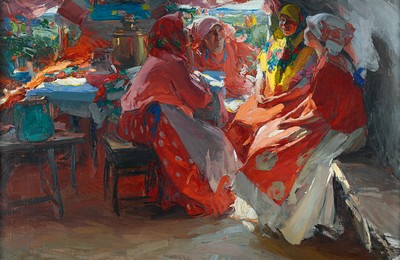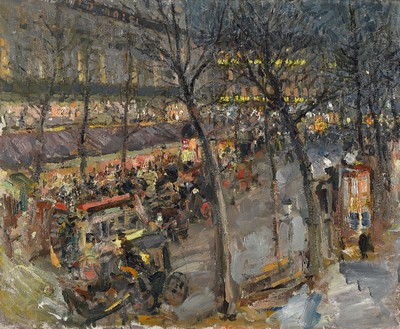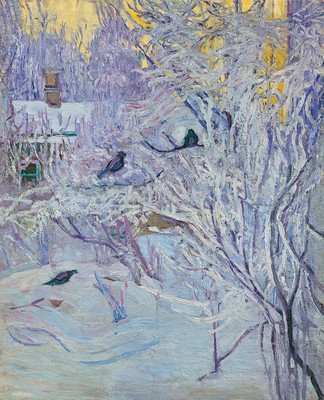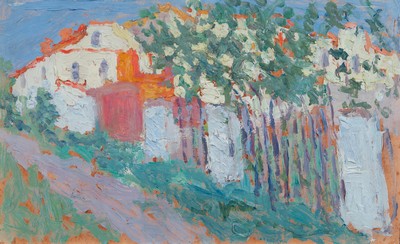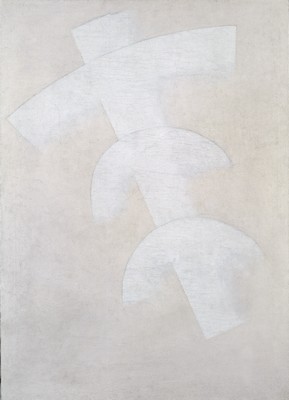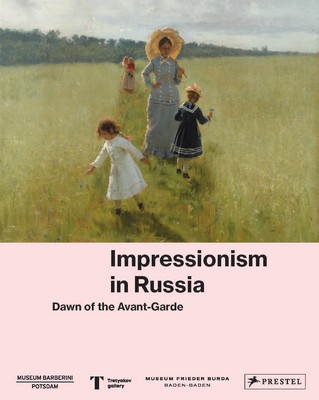Impressionism in Russia
Dawn of the Avant-Garde
Museum Barberini, Postdam
Through January 9, 2022
The Visit, 1914
Oil on canvas, 97.7 x 150 cm
State Tretyakov Gallery, Moscow
Moonlit Night, 1905
Tempera on canvas, 55 × 80.6 cm
State Tretyakov Gallery, Moscow
Paris was the prime destination for Russian artists before 1900. They could see works by Claude Monet and Auguste Renoir in the French capital, and they drew inspiration from the subject matter and painting style of the French Impressionists. Upon returning to Russia, they painted outdoors and sought to depict the fleetingness of a moment in their depictions of everyday life in Russia. Even painters who later became part of the Russian avant-garde developed their new art from the Impressionist study of light. This exhibition at the Museum Barberini is dedicated to the reception of French painting in Russia, a subject that has received little attention to date. With over eighty works, the show demonstrates the extent of their international visual vocabulary around 1900 and places Russian artists of the period––from Ilia Repin to Kasimir Malevich––in context of Western European modern art.
Paris: Café de la Paix, 1906
Oil on canvas, 60,3 x 73,5 cm
State Tretyakov Gallery, Moscow
Carnival Day in Paris, 1900
Oil on canvas, 100 x 65 cm
State Tretyakov Gallery, Moscow
“A brief glance at an Impressionist painting determined art history,” explains Ortrud Westheider, director of the Museum Barberini. “When Vasily Kandinsky encountered a work from Claude Monet’s series of Grainstacks in an exhibition in Moscow in 1896, he saw, to his confusion, a picture composed of bright colors––but was unable to recognize any particular object. This unsettling experience led him to renounce the idea of the motif in his work and inspired his artistic development toward nonrepresentative painting. While this anecdote is well-known, it is only a small piece in the mosaic of the complex relationship between French Impressionism and Russian art in the period between 1860 and 1925. Impulses from the Impressionists did not only revolutionize Kandinsky’s work; they were the starting point for numerous artists of the avant-garde who were to transform the Impressionist treatment of light into Rayonism, Cubo-Futurism, and Suprematism.”
As the leading European metropolis of art, Paris attracted painters from the academies of Moscow and St. Petersburg since the 1860s. Through their examination of the Impressionist style of painting modern life, they liberated themselves from the academic rules that governed Realist painting in Russia. Interaction with French painting inspired artists such as Ilia Repin, Konstantin Korovin, and Valentin Serov to produce works that in addition to the impression of the present moment also showed a sensory world that confronted modern life. Electric lights, shopwindow displays, and the architecture of the modern boulevards ofered them motifs that they treated with great painterly freedom. The visual efects of the changing times of day captivated them. The nocturnal illumination of streets especially fascinated Korovin and Nicolas Tarkhof, who made this topic popular in Russia.
Lelia Derviz, 1892
Oil on canvas, 67,5 x 45,5 cm
State Tretyakov Gallery, Moscow
Corner of the House and Bullfinches in the Tree: Winter, 1907–08
Oil on canvas on hard fiber, 63 x 51 cm
State Tretyakov Gallery, Moscow
The practice of painting outdoors that was inspired by the Impressionists transformed Russian art and made landscapes popular. Repin, Vasily Polenov, and their pupils Korovin and Serov explored nature around Moscow and traveled to the expanses of the north. Painting en plein air and a sketch-like style led artists to motifs that expressed a zest for life, encouraging a shift away from the existential subjects of Russian art. The changing sunlight lent a guise of lightness and optimism to their works. In portraits and pictures of families, Russian artists linked candor with psychological depth to create their own style of Impressionism. Questions of national identity were just as important as the relationship to the tradition of Realism in painting. Impressionism, with its focus on spontaneous expression and modernity that transcended borders, gave new impulses for dealing with this.
At the turn of the century summer houses in the country became a place of refuge for Russian urbanites. Artists captured the carefreeness of modern recreational activities at the datcha in Impressionist interiors that are suffused with light. Studies of light effects in indoor scenes and in still lifes led to a new appreciation of these genres that had received little attention at the academy in Moscow.
A second generation of Russian artists in Paris at the beginning of the twentieth century became acquainted with Post-Impressionism and Fauvism, painting styles that experimented with bright, unmixed colors. Like the French Post-Impressionists, many Russian painters of this generation aimed to have international careers and were interested in staying in the West for more than their studies.
Landscape painting became the first field of experimentation for artists such as Mikhail Larionov, Natalia Goncharova, and Kazimir Malevich. They considered themselves Impressionists before founding the Russian avant-garde with expressive Rayonism and nonrepresentational Suprematism after 1910. Now that color had been liberated, painters found the energy that stood for the dynamism and renewal of a new age. Impressionist observation was transformed into the Cubist and Futurist manner of breaking down of surfaces, which was made absolute as luminous nothingness in Kazimir Malevich’s series White on White.
Summer (or House and Garden), 1906
Oil on canvas, 19,2 x 31 cm
Collection of Vladimir Tsarenkov, London
Construction in Dissolution (Three Arches on a Diagonal Element in White), 1917
Oil on canvas, 98 x 70,5 cm
Stedelijk Museum Amsterdam
The exhibition includes over eighty loans from institutions such as ABA Gallery in New York, Museo Nacional Thyssen-Bornemisza in Madrid, the Collection of Iveta and Tamaz Manasherov in Moscow, the Collection of Vladimir Tsarenkov in London, the State Tretyakov Gallery in Moscow, the State Museum of Fine Arts of the Republic of Tatarstan in Kazan, the Collection of Elsina Khayrova in London, and the Stedelijk Museum in Amsterdam as well as from private collections, and it is presented in cooperation with the Museum Frieder Burda in Baden-Baden and the State Tretyakov Gallery.
The exhibition was curated by Ortrud Westheider and Alla Chilova. Various aspects of the exhibition’s subject matter were the subject of the 11th Symposium of the Museum Barberini in November 2019. The lectures held at the conference, including those by Olga Atroshchenko, State Tretyakov Gallery, Moscow; Rosalind P. Blakesley, University of Cambridge; Maria Kokkori, The Art Institute of Chicago; Susanne Strätling, Universität Potsdam; Irina Vakar, State Tretyakov Gallery, Moscow; and Tatiana Yudenkova, State Tretyakov Gallery, Moscow, are published in the exhibition catalog that accompanies the show.
Exhibited Artists: Abram Efimovich Arkhipov, Vladimir Davidovich Baranov-Rossiné, David Davidovich Burliuk, Vladimir Davidovich Burliuk, Robert Rafailovich Falk, Nicolai Fechin (Nikolai Ivanovich Feshin), Natalia Sergeevna Goncharova, Igor Emmanuilovich Grabar, Georgy Bogdanovich Iakulov, Alexej von Jawlensky (Aleksei Georgievich Iavlensky), Konstantin Alekseevich Korovin, Ivan Nikolaevich Kramskoy, Aleksandr Vasilevich Kuprin, Mikhail Fedorovich Larionov, Isaak Ilich Levitan, Kazimir Severinovich Malevich, Nikolai Vasilevich Meshcherin, Vasily Dmitrievich Polenov, Ilia Efimovich Repin (Ilya Répine), Olga Vladimirovna Rozanova, Valentin Aleksandrovich Serov, Nicolas Tarkhoff (Nikolai Aleksandrovich Tarkhov), Sergei Arsenevich Vinogradov, Stanislav Iulianovich Zhukovsky.
Exhibition and catalog: Ortrud Westheider and Alla Chilova
Edited by Ortrud Westheider, Michael Philipp, and Henning Schaper
Published by Prestel, Hardcover with dust jacket
264 pages, 24 x 30 cm, 200 color illustrations
Essays:• Tatiana Yudenkova: In the Land of Impressionism: Russian Artists’ Travels to France• Rosalind P. Blakesley: Realist Impressions or Impressionist Realities: A Complex Boundary in Russian Art• Olga Atroshchenko: A New Art: The Establishment of Impressionism in Russia• Susanne Strätling: Perceptual Force Fields: Impressionism and Energetics• Maria Kokkori: Color Is Light: From Impressionism to Suprematism• Irina Vakar: Dissolution of the Object: Impressionist Traditions in the Russian Avant-Garde
MUSEUM BARBERINI
Humboldtstr. 5–6, 14467 Potsdam

